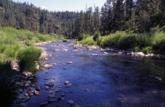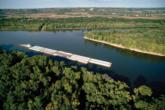Greatest smallmouth fisheries in America
Here are the top five smallmouth destinations that you may have never considered

Editor’s Note: This is the second article in a series on the greatest bass fisheries in America. Last month’s article covered largemouth fisheries, and next month’s article covers the best spotted-bass fisheries.
Recently the editors of FLW Outdoors Magazine conducted an in-depth survey to identify the greatest bass fisheries in America. Professional anglers, outdoor writers and tournament directors were polled, and while many of the results were expected, a number of lesser-known fisheries received numerous votes. These somewhat obscure fisheries may be well-known regionally, but many anglers across America know very little about, or have never heard of, them. Along with listing the overall top 10 smallmouth fisheries in the nation, we felt compelled to explore some of the outstanding yet unrenowned fisheries that every bass angler should know.
———————————————————-
 Black River
Black River
Two hours east of Phoenix, the White Mountains of Arizona give rise to the Black River. Geology has afforded the stream, which cuts steep canyons through primal rock, all the requisites of a great smallmouth fishery, replete with awe-inspiring backdrops at every bend in the river.
Bronzebacks were stocked in the Black River 60 years ago, and now it is locally renowned for consistently producing big bass. Interestingly, the smallmouth section of the river cuts through the mountains at an impressive elevation of 4,000 to 6,500 feet – one of the highest smallmouth streams in the country.
The river is accessible to anglers willing to do some literal legwork. Hiking is required to access the water in most places. More than 70 miles of stream make up the natural boundary between the San Carlos Apache and White Mountain Apache reservations. The river is most accessible from the San Carlos side, and a tribal permit is required. Nearby towns of Globe and Safford offer lodging, but using a hotel room for a base is not advised. Day trips are feasible, but staying overnight on the river is highly recommended.
For more information, contact the Arizona Game and Fish Department at (602) 942-3000 (www.gf.state.az.us).
– Craig Springer
———————————————————-
 New River
New River
The New River of Virginia and West Virginia is new in name only. This is the world’s second-oldest river, and it’s the Old Dominion’s best bet for trophy smallmouths, particularly during spring. It is quite possibly the best smallmouth fishery in West Virginia as well. The current Virginia state-record bronzeback, an 8-pound, 1-ounce beauty, hails from the New River.
“Virginia visitors should try spots near Interstate 81, in the Radford area,” said Barry Loupe, a New River expert from Saltville, Va.
For those willing to explore the New River valley a little more, go up to the New River Gorge National River area near Beckley, W. Va. The Appalachian scenery is remarkable, and the fishing is just as good as on the Virginia side.
There are several Virginia Department of Game and Inland Fisheries boat ramps to choose from, and float trips come highly recommended.
To order the New River Float and Fishing Trips guide, call (804) 367-1000 (www.dgif.state.va.us) or contact the New River Gorge National River park service at (304) 465-0508 (www.nps.gov/neri/home).
– Marc McGlade
———————————————————-
Broken Bow Lake
Tucked neatly away in the foothills of the majestic Ouachita Mountains of far southeastern Oklahoma lies one of that state’s best-kept secrets: Broken Bow Lake. With its crystal-clear water and numerous islands, the 14,200-acre gem is rapidly becoming one of the better-known smallmouth-bass fisheries in the region.
With the impoundment of the Mountain Fork River, which is known for an abundant population of native Ouachita-strain smallmouths, it was merely a matter of time before this lake exploded into a bronzeback angler’s dream come true.
Broken Bow is one of Oklahoma’s deepest lakes, with some areas reaching 140 feet, and its shoreline consists of mostly steep, rocky banks cradling clean, clear water – the perfect recipe for smallmouth bass to thrive and reproduce year after year.
Almost all of the lake’s smallmouths are hybrids of the river’s native strain and a Tennessee lake strain first introduced into the waters in 1993. Eleven years after that introduction, Broken Bow boasts smallmouth bass with the best features of each strain. The Ouachita smallmouths are known for their fierce, never-give-up battles from the point of hook all the way into the boat. The Tennessee strain grows larger than the native fish. The result: a fighting machine that Oklahoma anglers consider the state’s feistiest game fish.
Tournament anglers, who visit the lake with thoughts of abundant spotted bass and double-digit Florida largemouths (the Oklahoma state-record largemouth of nearly 15 pounds was caught here in March 1999), are noticing winning stringers consisting almost exclusively of smallmouth bass in the 2- to 6-pound range. Few Southern lakes can boast that kind of diversity in a bass population.
For more information, contact the Oklahoma Department of Wildlife at (405) 521-3721 (www.wildlifedepartment.com).
– Bob Gunn
———————————————————-
 Mississippi River
Mississippi River
Smallmouths in the Big Muddy? Absolutely.
Southern anglers would not recognize the upper sections of the Mississippi River (Red Wing, Minn., to La Crosse, Wis., in particular). The water is cool and much less stained than the lower parts of the river, and the smallmouths are abundant and overweight.
“The river around Red Wing is usually very clear,” said Tom Monsoor, a Wal-Mart FLW Tour pro from La Crosse, Wis. “The smallmouth fishing is excellent. The average fish is 2 to 3 1/2 pounds.
“The fishing, believe it or not, is even better near La Crosse. You can find big schools of smallies all weighing between 3 and 5 pounds. The water is usually fairly clear, but it all depends on the wind and rain runoff from the surrounding farmland.”
The whole upper Mississippi is really a neat fishery. There is vegetation and structure everywhere, and it all holds fish.
Relatively light smallmouth-fishing pressure allows anglers to get away from people and have a large area to fish in solitude. On a good day, anglers can boat 70 smallies. While certainly known in the region, anglers across America rarely hear of the quality smallmouth fishing found in the unique upper Mississippi River.
For more information on the upper Mississippi, contact the Wisconsin Department of Natural Resources at (608)266-2621 (www.dnr.state.wi.us).
– Chris Eubanks
———————————————————-
 Chautauqua Lake
Chautauqua Lake
Located in far western New York, Chautauqua Lake offers top-quality fishing, though it is rarely mentioned in national publications. Locals have proclaimed Chautauqua as the Muskie Capital of the World. Smallmouths, however, may soon claim a title of their own.
Lying in the quiet, historic countryside about 40 miles east of Erie, Pa., Chautauqua is a gorgeous lake chock-full of the fattest smallmouths in the country. Chautauqua Lake is about 17 miles long and covers approximately 13,000 acres. The lake consists of two basins, and with depths going more than 70 feet, the northern basin averages 25 feet deep. The southern basin, about equal in size, is much shallower with a maximum depth of only 19 feet. The overall fishery is outstanding – muskies, walleyes and even big largemouths often draw attention away from the trophy bronzebacks. Furthermore, nearby Lake Erie often garners a lot of the local angling attention, leaving Chautauqua fishermen free to roam the peaceful lake without competition.
How big do Chautauqua smallies get? In tournaments, anglers better catch five-fish limits around 23 pounds to compete for the win. Two- and 3-pound bronzebacks are so numerous that they occasionally annoy anglers searching for 5- and 6-pounders.
For more information, contact the Chautauqua County Visitors’ Bureau at (800) 242-4569 (www.chautauquafishhunt.com).
– Chris Eubanks
Top 10 smallmouth fisheries in America
1. Lake Erie – Lake Erie received more first-place votes than any other fishery in any category. It is undeniably the best smallmouth fishery in the United States. True, the lake can be broken into three separate regions (basins) because of its vastness, but as a whole, it is the best. As many anglers familiar with Erie proclaim, “There are no small fish in Erie.” Smallies over 5 pounds are nothing special in this top-notch fishery.
2. Lake Champlain – The huge natural lake along the New York/Vermont border is similar to Erie. Smallmouths are absolutely everywhere, and they are all fat as footballs. Champlain just does not produce quite the size found in Erie. The top-end fish are 6 pounds instead of 7 or 8 pounds.
3. Dale Hollow Lake – The world-record holder, Dale Hollow still grows big bronzebacks. The Tennessee/Kentucky impoundment is not discussed as much as it once was, but it is still the king of big smallmouths until overthrown. Catch rates are slightly lower as compared to many Northern fisheries, but size is larger. The 16- to 21-inch slot on smallies ensures bunches of fish in the 3- to 5-pound range are caught.
4. Chautauqua Lake – How do you pronounce that? Chautauqua Lake in far western New York is a 13,000-acre trophy-smallmouth factory. If fishing a tournament, you better have close to 20 pounds of smallies just to guarantee a place in the money. Read more about Chautauqua in the adjacent article.
5. Lake St. Clair/Detroit River – Very few world-class fisheries border a major metropolitan area. Lake St. Clair is connected to lakes Huron and Erie by the Detroit River, and downtown Detroit overlooks the lake. The smallmouth quality and numbers are hard to beat.
6. Lake Ontario – The region around Thousand Islands (northeast corner of the lake) holds a huge population of smallmouths. The smallies receive very light fishing pressure, and anglers can catch fish all day.
7. Kentucky/Barkley lakes – Already in the top 10 for largemouth fisheries, now Kentucky/Barkley comes in at No. 7 on the top smallmouth fisheries list. Very rarely will anglers catch the dozens of solid smallies that are produced each day on the great Northern fisheries, but the fish that are caught are often wall-hanging quality. Anglers are catching limits of smallies in the 25-pound range.
8. Lake Cumberland – The fishery at Cumberland is similar to that of its sister lake, Dale Hollow. The central Kentucky lake usually will not produce those 40-fish days common in the North, but the fish are healthy and strong. Bronzebacks over 6 pounds are caught on a regular basis.
9. Pickwick Lake – Upstream from Kentucky Lake on the Tennessee River, Pickwick may be the greatest Deep South smallmouth fishery. The lake holds the Mississippi record and produces 7-pounders regularly.
10. New River – The Virginia/West Virginia river is the only true river to make our top 10. In a region with many outstanding smallmouth streams/rivers, the New River rises to the top. Read more about the New River in the adjacent article.